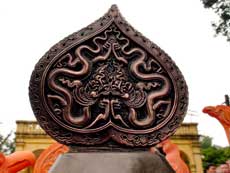On Dec 2, five sculptures featuring dragons from the Ly Dynasty were put on display by the Circle Group at the Kinh Thien Palace - Imperial Citadel of Thang Long, Hanoi, in a program named "Thousand-year message".
 The five sculptures include: a dragon image carved among leaves, and dragon and phoenix heads formed in many different materials, such as gems, bronze and ceramics, with lines forming the prototype of Ly era dragons which were found in the Imperial Citadel of Thang Long.
The five sculptures include: a dragon image carved among leaves, and dragon and phoenix heads formed in many different materials, such as gems, bronze and ceramics, with lines forming the prototype of Ly era dragons which were found in the Imperial Citadel of Thang Long.
In his address opening the exhibition, Prof. Dr. Nguyen Do Bao said Ly Dynasty dragons have features expressing authority, but still have lithe lines, expressing Vietnamese characteristics. This evidence demonstrates the cultural developments under the Ly Dynasty in the country's history.
Ly Dynasty dragons perfectly rounded bodies curve lithely, in a long sinuous shape, tapering gradually to the tail. The body has 12 sections, symbolizing 12 months in the year.
The dragon's back are small, uninterrupted, regular fins. The head, held high, is in proportion with the body, and has a long mane, beard, prominent eyes, crest on nose (pointing forwards), but no horns. The legs are small and thin, and usually 3-toed. The jaw is opened wide, with a long, thin tongue; the dragons always keep a gem or jewel in their mouths (a symbol of humanity, nobility and knowledge).